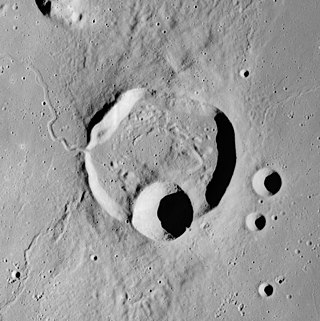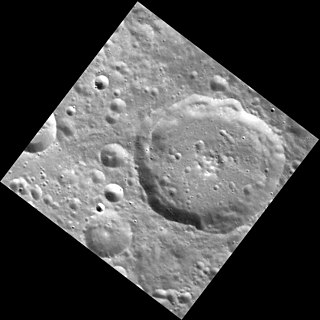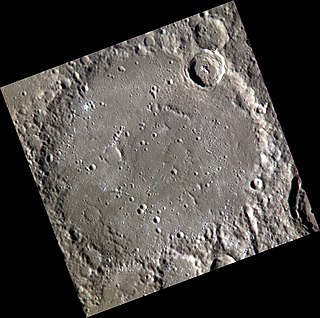
Alphonsus is an ancient impact crater on the Moon that dates from the pre-Nectarian era. It is located on the lunar highlands on the eastern end of Mare Nubium, west of the Imbrian Highlands, and slightly overlaps the crater Ptolemaeus to the north. To the southwest is the smaller Alpetragius. The crater name was approved by the IAU in 1935.

Auzout is a lunar impact crater that is located to the southeast of the Mare Crisium, near the eastern limb of the Moon. It is named after French astronomer Adrien Auzout."Auzout (crater)". Gazetteer of Planetary Nomenclature. USGS Astrogeology Research Program. Attached to the southern rim is the smaller crater van Albada. To the east-northeast is the large Condorcet. This crater is not especially notable, although it does possess a central mountain. This crater is designated 'Azout' in some sources.

Back is a small lunar impact crater that is located near the eastern limb of the Moon. It lies on the northwest edge of the Mare Smythii, and the northeast rim is adjacent to the crater Schubert. To the west is Jenkins, and to the southwest is the Weierstrass–Van Vleck crater pair.

Becquerel is a lunar impact crater that lies in the northern hemisphere on the far side of the Moon. This is an ancient and heavily worn formation that is now little more than an irregular buri in the surface. The outer rim has been worn and reshaped until it forms a rugged, mountainous region around the flatter interior.

Krieger is a lunar impact crater on the eastern part of the Oceanus Procellarum. It is located to the north-northwest of the flooded crater Prinz, and north-northeast of the prominent ray crater Aristarchus. To the northwest lies the small Wollaston. The crater was formally named in 1935.

Firmicus is a lunar impact crater that lies in the eastern part of the Moon's near side, so that from Earth it appears oval in shape due to foreshortening. It is, however, very nearly circular. The crater is located to the west of the Mare Undarum, and northeast of the similar-sized crater Apollonius. To the north of Firmicus are the craters van Albada and Auzout. Attached to its northwest rim is the Lacus Perseverantiae, a miniature lunar mare.

Matisse is an impact crater on the southern hemisphere of Mercury. Matisse takes its name from the French artist Henri Matisse, and it was named by the IAU in 1976.

Bernini is a crater on Mercury. It has a diameter of 146 kilometers. Its name was adopted by the International Astronomical Union (IAU) in 1976. Bernini is named for the Italian architect and sculptor Gian Lorenzo Bernini, who lived from 1598 to 1680.

Burns is a crater on Mercury. It has a diameter of 43 kilometers. Its name was adopted by the International Astronomical Union (IAU) in 1985. Burns is named for the Scottish poet Robert Burns, who lived from 1759 to 1796.

Chŏng Chʼŏl is a crater on Mercury. It has a diameter of 143 kilometers. Its name was adopted by the International Astronomical Union (IAU) in 1979. Chŏng Chʼŏl is named for the Korean poet Jeong Cheol, who lived from 1536 to 1593.

Dickens is a crater on Mercury. It has a diameter of 78 kilometers. Its name was adopted by the International Astronomical Union (IAU) in 1976. Dickens is named for the English novelist Charles Dickens, who lived from 1812 to 1870.

Nizāmī is a crater on Mercury. Its name was adopted by the International Astronomical Union (IAU) in 1979. Nizami is named for the Persian poet Nizami Ganjavi, who lived from 1141 to 1209.

Karsh is a crater on Mercury. It has a diameter of 58 kilometers. Its name was suggested by American resident Elizabeth Freeman Rosenzweig in a naming contest which was eventually adopted by the International Astronomical Union (IAU) on 2015. Karsh is named for the Armenian-Canadian photographer Yousuf Karsh. The craters Carolan, Enheduanna, Kulthum, and Rivera were also named as part of the contest.
There are a number of objects in the solar system that have been named after Chinese people or places. Many of these are craters on the terrestrial planets but asteroids and exoplanets have also received Chinese names.














